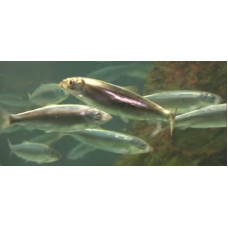Clupea is a genus of fish in the family Clupeidae. Length is usually 33-35 cm, rarely up to 50 cm. They are distributed in temperate subarctic waters of the northern parts of the Atlantic and Pacific Oceans. Gregarious marine, partly brackish-water pelagic fishes. Subdivided into multi-vertebrate and small vertebrate, differing from each other in the number of vertebrae, the degree of development of teeth and biological features. Includes 3 species: Atlantic with subspecies (Clupea harengus), Eastern (Clupea pallasi) with subspecies and Chilean (Clupea bentincki).
Body compressed from sides, with serrated edge of abdomen. Scales are moderate to large, rarely small. The upper jaw does not protrude beyond the lower jaw. The mouth is moderate. Teeth, if present, are rudimentary and falling out. The anal fin is moderately long and has fewer than 80 rays. The dorsal fin is located above the pelvic fins. The caudal fin is bifurcated. This genus includes 9 species. Their food is a variety of small animals, especially small crustaceans. All representatives of the genus have an important commercial value, used for food, as well as for the manufacture of fishmeal. The Pacific (Clupea pallasii) and Atlantic (Clupea harengus) are especially important economically.
The area of distribution of Clupe occupies the Atlantic Ocean (both off European and North American coasts), north to southern Greenland and Finnmark, south to the Bay of Biscay; the Baltic Sea with its bay (it is the small species called salaca), Finnmark, the Murmansk coast, and the White Sea (mainly off the western and southern coasts); and the Pacific Ocean.
Clupe spends part of its life in deep water. Its oceanic fishery in Europe starts annually near the Shetland Islands, where the area of relative shallowness begins, and gradually moves further and further south. The spawning season lasts all year and occurs at different times in different places. Often two separate main periods can be established for one area; thus, in the Baltic Sea spawning occurs before the beginning of summer and after the end of summer, in the ocean - before the beginning of winter and at the end of winter. Large herring spawn at greater depths (up to 130-215 meters), while small herring spawn closer to the shore, sometimes at 2 meters depth and often in less salty parts of the sea. For spawning, herring gather in colossal flocks, sometimes so dense that pressure from the lower fish pushes the upper ones out of the water. The water becomes murky, and a pungent odor is spread over a considerable distance. Masses of fertilized eggs sink to the bottom and stick to underwater objects or stick together in clumps. The number of eggs in the female is approximately 20-40 thousand. The diameter of the eggs of the Baltic Sea Clure is usually from 0.92 to 1 mm, oceanic Clure from 1 to 1.3 mm. It takes about 2 weeks before the larvae emerge from the eggs, but development is shortened to a few days at high temperature.
Their food consists mainly of small crustaceans, especially Copepoda, but small fish are also found in their stomachs. Studies show that the proximity of Slurpees to the shores, on which the success of shore fishing depends entirely, is directly related to the distribution of water masses with high salinity and temperature.
Clupea
Tags: clupea




